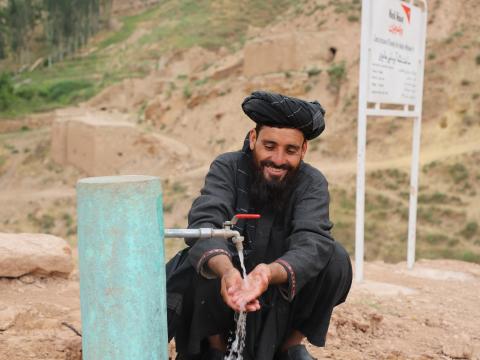The gift of clean drinking water

Before the construction of a drinking water system, 150 households in Safidara village in Badghis Province of Afghanistan did not have enough drinking water in their houses. This had a negative impact on their lives, particularly children’s health and education.
“We had hard days accessing water. We used to travel roughly four kilometers by donkey to reach the stream. It takes two hours,” says Ezatullah, 37, the village head. He explains, “There were a lot of people coming to fetch water, and we had to wait in line for our turn. If you would go in the morning, you would come back home at 5 o’clock in the evening. The way to the stream has its own problem of ups and downs, causing people to carry jerrycans by hand for part of the journey. This was the daily struggle of people living here.”
The problem became more serious in the winter. “We couldn’t go to the stream in the winter. The route was blocked and we had to use water from snow falling on the roofs of our houses,” Ezatullah added.
The situation with water also caused the closure of the community based school. "We had a community school that was established by the efforts of the community people. The children loved attending the school. Sadly it didn’t last long due to the water problem. During the school hours children were used to fetch water while and were missing classes. The school was closed after two years of operating," says Ezatullah
To address the severe need for water and improve access to drinking water for affected communities, World Vision Afghanistan’s technical team, along with the community leaders, identified the location for the water networks. Three water supply networks were constructed in communities in Badghis province. One gravity fed water supply network (this system is running by gravity force not solar or any electricity) was constructed in Safidara village linked to the spring located 30 kilometres away. The community members contributed by providing the labour to support infrastructure construction. Financial support was provided by donors from Canada.
This intervention helped community members to access drinking water near their houses. It also reduced the time and distance to water sources. “The work was completed in just one month and now we have drinking water,” explains Ezatullah with a happy face.
Ahmad, 12, is one of the children in the community. He recalls his bad memories. “One day I had four jerrycans. I filled the jerrycans with water. On the way back home, the donkey fell over and my jerrycans were torn. Only one of them had water left. I cried a lot,” he said.
I will never forget the days when I didn’t drink water for the whole day.
Ahmad is now happy to have easy access to drinking water.
Access to water source revived the hope of having back community school in the future. "We have a plan to pitch a tent again since there is no need for children spend long hours to fetch water far from their houses," Ezatullah explains.
World Vision handed the water systems over to the communities and trained water management groups (WMGs) to operate and maintain the systems. This approach supports the ongoing functionality of the systems. “In order to support system sustainability, we [community members] gathered together and selected one of the community members to manage water as per people’s need, and he is committed to this,” Ezatullah explains.